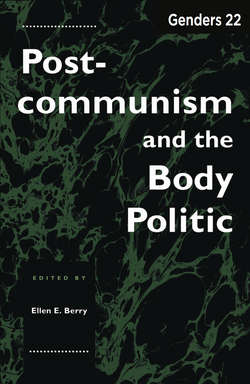Читать книгу Genders 22 - Ellen E. Berry - Страница 10
На сайте Литреса книга снята с продажи.
ONE Bug Inspectors and Beauty Queens: The Problems of Translating Feminism into Russian
ОглавлениеBeth Holmgren
A few years ago, when the Russian writer and lecturer-provocateur Tat’iana Tolstaia was endorsing the “truth” of Francine du Plessix Gray’s book on Soviet women, she penned this grim portrait of Western feminists rapping on the collective door of Soviet women and grilling them in the “cold, rigid manner” of bug inspectors: “How do your men oppress you? Why don’t they wash the dishes? Why don’t they prepare the meals? Why don’t they allow women into politics? Why don’t women rebel against the phallocracy?”1 As comforting as it might be to dismiss this image as typical Tolstoyan reductionism, a less extreme version of it recurs in the commentary of Ol’ga Lipovskaia, the editor/publisher of the journal Zhenskoe chtenie (Women’s reading). Lipovskaia remarks on Western feminists’ bewildered, sometimes alienating contacts with Soviet women — the “real confusion of purposes and activities” manifest in various official meetings between the two groups, Western women’s one-track insistence on the value of their own agendas, the problem with effectively translating the most basic Western terms like “feminism,” “emancipation,” and “gender” for a slogan-weary Soviet audience.2
Impressions from the other side of the border record similar misconnections and sometimes vent a counter-dismay. Reporting in a January 1993 issue of the Nation, Andrew Kopkind notes the lack of a Russian feminist movement and Russian adoption “in the space of a few months” of “some of the West’s most reactionary gender roles and sexual stereotypes.”3 As he selectively interviews self-avowed Russian feminists like Lipovskaia and Anastasiia Posadskaia (the director of Moscow’s Center for Gender Studies), Kopkind relays stories and statistics sure to upset a Western feminist readership — for example, Russian women’s seeming acquiescence to a new, markedly Western brand of sexploitation (55) or the polls showing the rising number of Russian women who yearn to be full-time homemakers or aspire no further than the very often prone position of “secretary to a biznesman who earns hard currency” (50). In an article of 11 February 1993 for the Los Angeles Times, Elizabeth Shogren simply frames her survey of Russian women in Western terms, stating that these women “[b]y their own choice and because of mounting new social pressures … are less liberated, in the feminist sense, than they were when the Communist Party ruled the country.”4 Even Shogren’s Russian source, the social anthropologist Irina Popova, seemingly relies on American analogies: “Russian society is going through a phase similar to that in 1950s America, when homemakers and wholesome stars were idealized, … but because of a rebellion against the state-decreed sexual puritanism of the Soviet era, the ideal Russian woman is more sex kitten than homecoming queen.”
All of these attempted border crossings, with whatever intent or audience in mind, underscore the real difficulties of translating and transposing even a mainstream Western awareness of gender issues into the Russian (or generally Slavic) context. As one observer remarks, such crossings are liable to produce a kind of “mirror inversion” of images: Whereas Russian women sight the bogeywoman of doctrinaire or self-involved Western feminists, Western women lament what is for them the inexplicable “backwardness” of Russian women retreating to the home or readily consenting to play well-paid male sex object.5 This mutual misunderstanding seems especially pointed today, but it has existed for decades and pervades both popular attitudes and presumably more complex and considered trends in scholarship. I can offer myself as witness and accessory to this phenomenon. As an American woman trained to be a Slavist and beginning my teaching career in the late 1980s (when women’s studies programs were being established throughout the American university system), I have experienced these border troubles firsthand and at length. Already minted as a traditional scholar, I only learned about gender studies “on the job” from patient colleagues in other fields, and much to my surprised delight, this exposure revitalized and transformed my own research and teaching. Yet I quickly discovered that the integration of gender studies into Slavic studies involved complicated acts of translation and adaptation — acts that distanced me somewhat from my colleagues in women’s studies and for the most part disaffected or bemused my Slavist colleagues. As I have taught and written my way back and forth across this border, I have come to appreciate that the misunderstanding between Western women and Russian women and, by extension, the recurring difficulties of integrating gender studies into Slavic studies, stem from complex differences between first and second worlds, between two very separate contexts of experience, expectation, and expression. This essay attempts only a utilitarian sketch of these border troubles mainly drawn from a first world angle and focused on a limited number of examples, but it provides, hopefully, a somewhat experienced traveler’s “tips” for making a friendly border crossing, a mutually informed and transformative exchange with women in postcommunist Russia.
